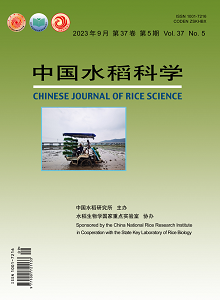【Objective】 To elucidate the effects of exogenous silicon (Si) on plant height, dry weight, antioxidant enzyme system, and the expression levels of Cd2+ related genes in rice under cadmium (Cd) stress, so as to lay a theoretical basis for clarifying the mechanism of Si in alleviating Cd toxicity in rice. 【Method】 Indica rice Fupin 36 (FP36) and Zhongjiazao 17 (ZJZ17) were hydrocultured under two Cd2+ concentrations (0, 5 µmol/L) and three Si treatments (0, 10 µmol/L, 1 mmol/L). The agronomic traits, antioxidant enzyme activities, and the expression levels of Cd2+ uptake/transport-related genes were analyzed. 【Result】 Cadmium stress significantly inhibited the agronomic traits and activities of antioxidant enzymes (superoxide dismutase, peroxidase, catalase, and ascorbic acid oxidase) of ZJZ17 and FP36, but exogenous Si addition could effectively alleviate the toxicity of Cd to rice, and enhance the activities of antioxidant enzymes. Moreover, 1 mmol/L Si treatment exerted a better alleviating effect on Cd stress than 10 µmol/L Si. In addition, Cd stress also affected the contents of soluble protein and malondialdehyde (MDA) in rice, while Si exposure increased soluble protein content but decreased the MDA content, respectively. Cd intervention significantly increased Cd content in different tissues of FP36 and ZJZ17, and its accumulation in roots was significantly higher than that in shoots. However, there was no significant difference in Cd content in rice plants under 10 µmol/L Si addition; and Cd accumulation in rice was significantly decreased as exposed to 1 mmol/L Si at 5 µmol/L Cd2+ concentration, indicating that the Cd accumulation in shoots was higher than that in roots. The expression levels of Cd2+ uptake/transport-related genes followed different trends as subjected to Cd stress and Si treatments. Compared with zero-Cd treatment, the expression levels of OsNRAMP1, OsIRT1 and OsHMA2 were up-regulated under Cd stress, while OsNRAMP5 expression tended to be down-regulated, and the expression level of OsHMA3 remained unchanged. Moreover, the expression levels of OsNRAMP1, OsNRAMP5, OsIRT1, OsHMA2, OsHMA3 were significantly decreased at 1 mmol/L Si concentration. 【Conclusion】 Silicon alleviates the toxicity of Cd to rice by improving the agronomic traits, activating the antioxidant system, and regulating the expression levels of Cd2+ uptake/transport-related genes.

